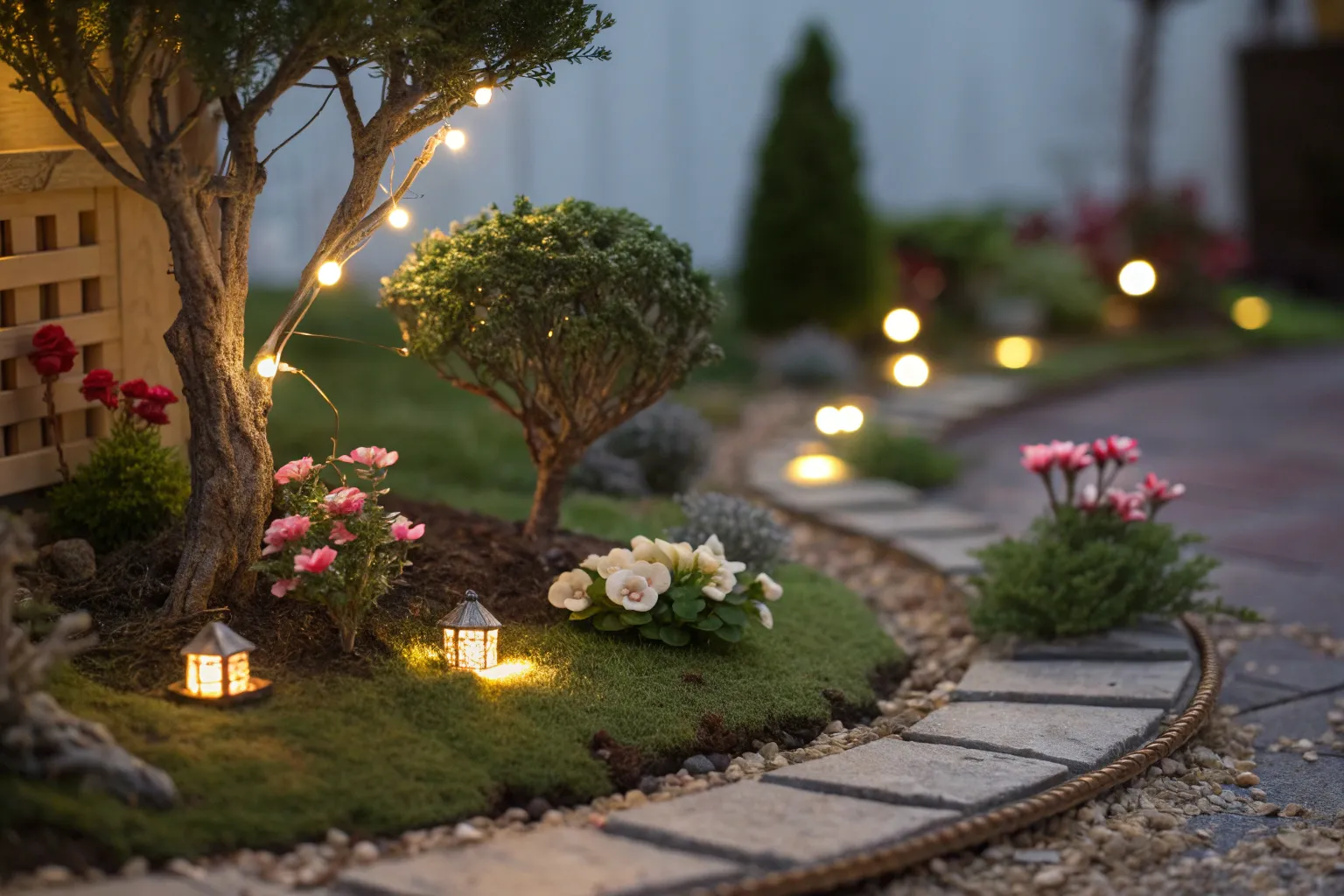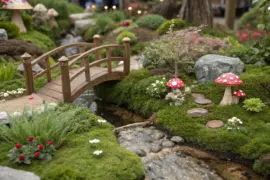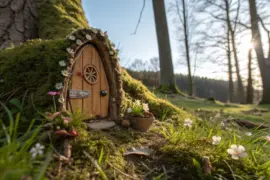When the sun dips below the horizon, your fairy garden doesn’t have to sleep. The magic between day and night—that dreamy in-between called twilight—is when an enchanted garden truly comes alive.
Setting the Stage for Twilight

Before a single light glows, think about the world you’re creating. I’ve learned that the most captivating twilight scenes start with intention. Picture your fairy realm at dusk: Are fireflies dancing above a mossy path? Does warm light spill from tiny windows? Is moonlight catching on a miniature pond?
Consider your base and backdrop. A shallow wooden tray, ceramic planter, or glass terrarium all work beautifully for miniature gardens. The container you choose influences how light moves through your scene—open gardens allow light to scatter naturally, while enclosed terrariums create concentrated pools of glow.
Build your foundation with potting soil, adding texture with natural materials like small pebbles for pathways, preserved moss for ground cover, and bits of bark for organic structure. These earthy elements provide depth and contrast, making your lights shine more dramatically when twilight arrives.
The Heart of the Scene: Simple Structures

Creating Fairy Dwellings
Your enchanted garden needs homes, and making them yourself brings genuine magic to the project. You don’t need fancy materials—just imagination and patience.
For a beginner-friendly approach, gather natural supplies from your own yard: small twigs, flat pieces of bark, acorn caps, and pinecones become building blocks. Hot glue is your best friend here. Create a simple dome house by gluing twigs in a teepee shape, or stack flat bark pieces like rustic shingles on a small cardboard base.
Polymer clay mushroom houses are another wonderful option that works perfectly for all ages. Roll white or tan polymer clay into a ball for the mushroom stem, then flatten the bottom so it stands upright. For the cap, roll a larger ball of red, brown, or cream clay and press it into a dome shape with your thumb. Attach the cap to the stem with a tiny bit of clay or craft glue. Before baking according to package directions, add spots or texture with dotting tools or even a toothpick.
These mushroom homes feel genuinely magical—like something fairies crafted themselves.
Building Miniature Furniture
Small details transform a garden from pretty to enchanting. Tiny furniture adds story and invites the imagination to linger.
Craft a miniature bench from three small twigs: two equal lengths for legs, one slightly longer for the seat. Glue them together in a simple H-shape. For a table, find a flat piece of bark or a large wood slice and glue it onto a small twig “trunk.”
Acorn caps become perfect fairy bowls. Moss-covered stones can be arranged as stepping stones or seating areas. The beauty of these simple elements is that children and adults alike can create them without special skills—just a willingness to see possibilities in small things.
Bringing Twilight to Life: Lighting Techniques

This is where your garden truly awakens. Lighting creates atmosphere, draws the eye, and turns a static scene into a living world.
Battery-Operated Fairy Lights
These are your most versatile tools for enchanted lighting. Battery-operated LED string lights come in various lengths, from 20 to 200 tiny bulbs on flexible wire. The thin wire disappears easily among plants and structures, while the small LED bulbs create points of light that suggest fireflies, lanterns, or magic itself.
Choose warm white lights (2700K-3000K) for a cozy, candlelit glow that feels traditional and inviting. These lights have a gentle golden quality that makes your garden feel inhabited and welcoming. Cool white lights (4000K-5000K) create a more ethereal, moonlit atmosphere—perfect if you’re going for an icy fairy realm or mystical forest.
Placement strategies matter more than you might think. Weave lights along pathways to guide imaginary visitors through your garden. Tuck a few bulbs inside fairy houses so warm light appears to glow from within—poke small holes in cardboard or bark structures to let light escape, creating tiny windows. Wrap lights loosely around miniature arbors or trees to suggest lanterns hanging from branches.
For a magical touch, arrange lights near or under your miniature pond area (using blue glass beads or marbles) so they reflect and create the illusion of bioluminescence.
Battery life typically ranges from 120 to 360 hours, and many sets include timers that automatically turn lights on each evening—less work for you, more consistent magic for your garden.
Creating Glowing Mushrooms
Transform simple craft supplies into enchanted lighting elements. Take battery-operated LED lights and craft miniature mushroom caps from translucent materials.
One approach: Use transparent silicone sealant to form small mushroom cap shapes over individual LED bulbs on wire lights. While the silicone is still soft, sprinkle on fine glitter or translucent paint to add color. Once cured, these create glowing toadstools that look genuinely magical at twilight.
Another method for older children uses polymer clay mixed with translucent clay—this creates a semi-transparent quality that allows LED light to shine through softly. Shape your mushroom, insert a small LED light underneath or behind it before it cures, and you’ve created a fairy lamp.
Solar-Powered Options
For outdoor enchanted gardens, solar lights eliminate battery changes entirely. Small solar mushroom lights, ladybugs, butterflies, and flowers charge during the day and automatically illuminate at dusk. These work beautifully scattered throughout a garden bed, creating points of light that surprise and delight.
Solar lights typically glow for 6-8 hours after a full day of charging, and they’re weather-resistant for year-round enchantment.
Layering Light for Depth
Professional lighting designers talk about “layering” light, and this principle works brilliantly in miniature. Don’t rely on one light source—combine several for a richer, more dimensional scene.
Ambient lighting sets your overall mood. This might be string lights draped overhead or woven throughout the garden, providing general twilight glow.
Accent lighting highlights special features. A small spotlight (even a tiny LED tea light) placed behind a fairy house creates dramatic silhouette effects. Lights tucked under moss or behind stones create mysterious pools of glow.
Practical lighting serves a story purpose. Lights inside houses, along pathways, or near a tiny “campfire” (arranged stones with an LED tea light beneath) all suggest someone lives here and uses these lights.
This layering creates depth—your eye travels through the scene rather than seeing everything at once.
Adding Beings and Creatures (Kid-Friendly)

Your enchanted garden can include gentle creatures that feel at home in a magical twilight world.
Polymer clay or air-dry clay animals work wonderfully for beginners. Create simple shapes like rabbits, birds, hedgehogs, or mice. Roll clay into basic ball and oval shapes, attach them together, and add small details with toothpicks before letting them cure or bake. Paint with acrylics in natural woodland colors.
For miniature fairy figurines, choose whimsical, child-appropriate designs—fairies reading books, tending gardens, or sitting on mushrooms create peaceful, story-rich scenes. Avoid anything dark or overly detailed that might not suit younger audiences.
Tiny resin animals like deer, foxes, or butterflies can be found inexpensively and add immediate life to your scene. Position them along pathways or near water features, as if they’ve come to visit at twilight.
If you want to create your own creatures but lack sculpting confidence, try simple wire armatures wrapped with yarn or natural fiber. Bend thin craft wire into basic animal shapes—four-legged creatures are easiest—then wrap colored yarn around the wire frame, securing with tiny dots of glue. These folk-art style animals have tremendous charm and work perfectly in rustic enchanted gardens.
Finishing Touches for Twilight Magic
Pathways and Ground Texture
Coarse sand, aquarium gravel, or crushed walnut shells create pathways that catch and reflect light. Sprinkle them between plants and structures, using a small paintbrush to sweep them into natural-looking trails.
Living or preserved moss adds lushness, though remember that preserved moss won’t grow and needs occasional misting to maintain its look. For living gardens, collect small amounts of moss from your own yard—it brings authentic texture and actually thrives in miniature environments with proper care.
Water Features
You don’t need actual flowing water to suggest a stream or pond. Clear glass marbles, blue sea glass, or smooth river stones arranged in a winding pattern create the illusion of water. When you place lights nearby, these surfaces catch and reflect the glow, suggesting moonlight on water or magical luminescence.
Atmospheric Elements
Consider adding tiny details that suggest life and story: a miniature watering can with lights “pouring” out (wire lights arranged to flow from the spout), a small mirror laid flat and surrounded by moss to create a fairy pool, or twisted wire shaped into a simple arbor with climbing silk flowers.
Each detail doesn’t need to be perfect—it needs to suggest something, to invite the viewer to imagine the rest.
Caring for Your Twilight Garden
Living elements need attention. If you’ve included real plants or moss, mist lightly once or twice weekly depending on your climate. Remove any dead leaves or faded flowers promptly.
Battery-operated lights should be turned off during the day to extend battery life, unless you have automatic timers. Check connections occasionally—wire lights can shift with watering or handling.
Replace or refresh preserved moss if it fades or develops mold. Wipe down resin figurines and structures gently with a dry cloth to remove dust.
Your enchanted garden will evolve naturally. Some plants will grow and need gentle trimming. Lights might need repositioning as elements settle. This evolution is part of the magic—your twilight world becomes a living project rather than a static display.
The Magic of Making
Creating an enchanted garden lit for twilight isn’t about perfection. It’s about building a small world that sparks wonder—for yourself, for children, for anyone who pauses to look closely.
The process itself is meditative. Arranging tiny elements, testing where light falls most beautifully, watching your scene come together piece by piece—these small creative acts offer calm and satisfaction in a busy world.
When evening comes and you switch on those lights, you’ll see your work transformed. What was charming in daylight becomes genuinely magical in the glow of twilight. Shadows deepen. Lights twinkle. Your miniature world feels inhabited, alive, waiting for its fairy residents to emerge from their mushroom houses and begin their evening adventures.
That’s the real enchantment—not just what you’ve made, but what you’ve invited others to imagine.





